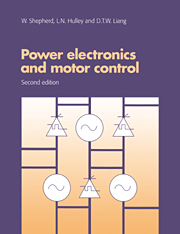Book contents
- Frontmatter
- Contents
- Preface to first edition
- Preface to second edition
- List of principal symbols
- 1 Power switching theory
- 2 Switching devices and control electrode requirements
- 3 System realisation
- 4 Adjustable speed drives
- 5 D.c. motor control using a d.c. chopper
- 6 Controlled bridge rectifiers with d.c. motor load
- 7 Three-phase naturally commutated bridge circuit as a rectifier or inverter
- 8 Single-phase voltage controllers
- 9 Three-phase induction motor with constant frequency supply
- 10 Induction motor slip-energy recovery
- 11 Induction motor speed control by the use of adjustable voltage, adjustable frequency step-wave inverters
- 12 Induction motor speed control by the use of adjustable frequency PWM inverters
- Appendix General expressions for Fourier series
- Answers to problems
- References and bibliography
- Index
Preface to first edition
Published online by Cambridge University Press: 05 June 2012
- Frontmatter
- Contents
- Preface to first edition
- Preface to second edition
- List of principal symbols
- 1 Power switching theory
- 2 Switching devices and control electrode requirements
- 3 System realisation
- 4 Adjustable speed drives
- 5 D.c. motor control using a d.c. chopper
- 6 Controlled bridge rectifiers with d.c. motor load
- 7 Three-phase naturally commutated bridge circuit as a rectifier or inverter
- 8 Single-phase voltage controllers
- 9 Three-phase induction motor with constant frequency supply
- 10 Induction motor slip-energy recovery
- 11 Induction motor speed control by the use of adjustable voltage, adjustable frequency step-wave inverters
- 12 Induction motor speed control by the use of adjustable frequency PWM inverters
- Appendix General expressions for Fourier series
- Answers to problems
- References and bibliography
- Index
Summary
This book is intended as a teaching textbook for advanced undergraduate and postgraduate courses in power electronics. The reader is presumed to have a background in mathematics, electronic signal devices and electric circuits that would be common in the early years of first degree courses in electrical and electronic engineering. It is the writers' experience that engineering students prefer to learn by proceeding from the particular to the general and that the learning route be well illustrated by many worked examples. Both of these teaching practices are followed here and a lot of problems are also included for attempt and solution at the ends of most chapters.
About one half of the text was written while the principal author (W.S.) was on study leave at the Department of Electrical and Computer Engineering, University of Wisconsin, Madison, Wisconsin, USA. His grateful thanks are acknowledged to the stimulating company of Professor Donald Novotny and Professor Tom Lipo during this period of sabbatical scholarship, sponsored by the Fulbright Commission.
It has become evident in recent years that the reign of the silicon controlled rectifier member of the thyristor family, as the universal semiconductor power switch, is drawing to a close. Except in very high power applications the technology of the immediate future lies with three-terminal, control electrode turn-off devices such as the gate turn-off thyristor (GTO), the bipolar power transistor and the field effect power transistor (FET).
- Type
- Chapter
- Information
- Power Electronics and Motor Control , pp. xv - xviPublisher: Cambridge University PressPrint publication year: 1996

